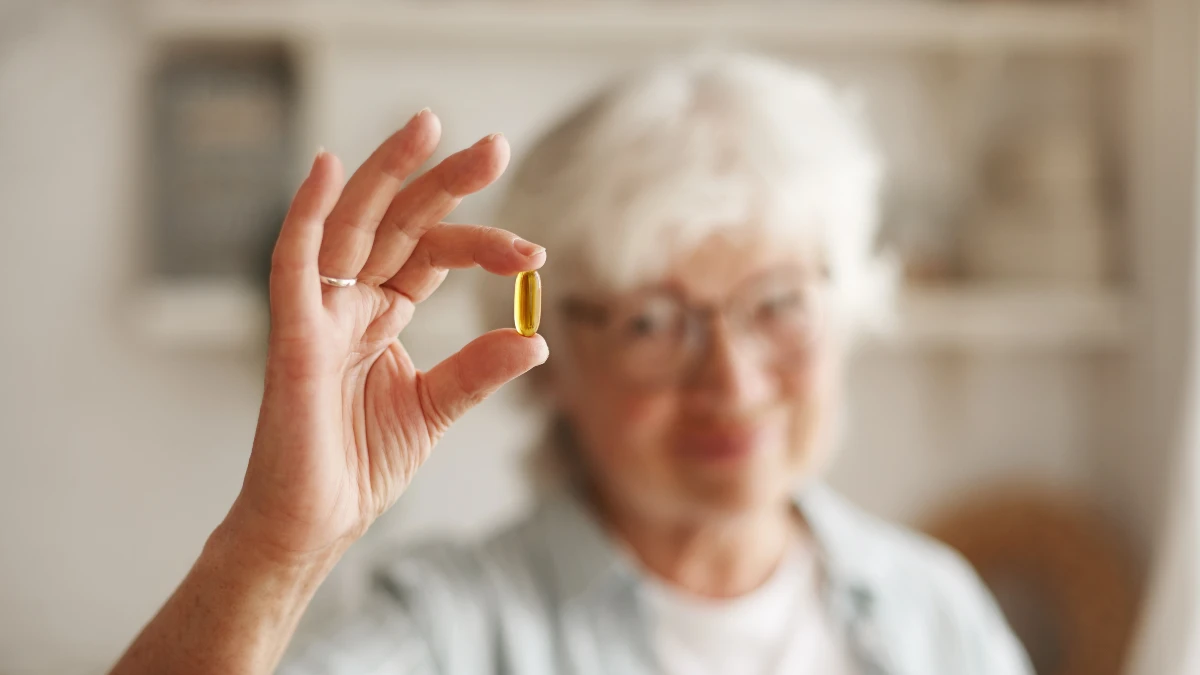Many women over 40 feel tired, gain weight, and battle mood swings, often blaming it all on aging. The real issue is frequently hormonal, and a key player is widely misunderstood: Vitamin D.
We think of it as the bone vitamin, but it’s a powerful hormone that directs everything from stress to metabolism. A lot of the hormonal chaos women experience comes from simple mistakes in how they use this nutrient.
This guide breaks down those errors and provides a clear plan to help you balance your hormones and reclaim your energy
How Your Body Turns Sunshine into a Super-Hormone
The Essential Journey: Vitamin D’s Transformation
Step 1: Sunlight Exposure (Skin)
UVB rays activate 7-dehydrocholesterol in the skin, synthesizing **Pre-Vitamin D3**, which rapidly converts to **Vitamin D3 (Cholecalciferol)**. Dietary sources like fatty fish also provide D3.
Step 2: First Hydroxylation (Liver)
Vitamin D3 travels to the liver. Here, the enzyme **25-hydroxylase** adds a hydroxyl group, converting it into **25-hydroxyvitamin D [25(OH)D]**, also known as calcidiol. This is the main circulating form, measured in blood tests.
Step 3: Second Hydroxylation (Kidneys)
25(OH)D moves to the kidneys. The enzyme **1α-hydroxylase** adds another hydroxyl group, transforming it into **1,25-dihydroxyvitamin D [1,25(OH)2D]**, also known as calcitriol. This is the **biologically active hormone**.
Step 4: Hormonal Action & Regulation
Active calcitriol regulates calcium and phosphate levels, impacting bone health, immune function, and cell growth. Its production is tightly controlled by **PTH (parathyroid hormone)** and serum calcium/phosphate levels.
Key Facts on Vitamin D & Health
- **Global Deficiency:** An estimated **1 billion people** worldwide have Vitamin D deficiency or insufficiency.
- **Bone Health:** Vitamin D is crucial for calcium absorption, preventing conditions like **osteoporosis** and **rickets**.
- **Immune Support:** Emerging research links adequate Vitamin D levels to a **robust immune response** and reduced risk of autoimmune diseases.
- **Non-Skeletal Roles:** Receptors for active Vitamin D are found in nearly every tissue, suggesting roles beyond bones, including **cardiovascular health** and **mood regulation**.
“Vitamin D is not just a vitamin; it’s a neuro-steroid that impacts hundreds of genes throughout the body. Its transformation from a simple nutrient to a potent hormone underscores its critical role in health and disease prevention.”

To see how much Vitamin D affects your hormones, you first need to know how it changes from a simple nutrient into a powerful hormone. This isn’t a simple process. It’s a carefully controlled path that shows how important it is for your body.
From Sunlight to a Hormone: A Quick Trip
The story of Vitamin D starts in your skin, not on your plate. When sunlight’s UVB rays hit your skin, they turn a type of cholesterol into a pre-Vitamin D3. This quickly becomes cholecalciferol, or Vitamin D3. You can also get Vitamin D3 from foods like fatty fish and egg yolks.
But this Vitamin D3 is not active yet. It’s just the raw material. To get to work, it needs to go through a two-step activation process.
- First Stop (The Liver): Vitamin D3 travels to your liver. An enzyme there adds a special molecule to it, turning it into 25-hydroxyvitamin D, or 25(OH)D. This is the form of Vitamin D that flows through your blood. A blood test for 25(OH)D is the best way to check your overall Vitamin D status.
- Final Activation (The Kidneys): From the liver, it goes to the kidneys. Here, another enzyme adds a second molecule, turning it into calcitriol. This is the fully active, hormonal form of Vitamin D. It is much more powerful than its earlier forms. While your kidneys do most of this work, other parts of your body, like your immune cells, can also activate Vitamin D for their own local use.
This process shows a key truth: your body doesn’t just use Vitamin D, it makes a hormone out of it. How this path is controlled, especially the final step, is very important. If something is wrong with your calcium levels or certain glands, your body might not be able to make the active hormone, even if your blood tests look okay. This is why just taking a Vitamin D pill isn’t always enough.
How This Hormone Talks to Your Cells
The real power of active Vitamin D is its ability to talk directly to your cells’ genetic machinery. It works just like other steroid hormones, such as estrogen or testosterone.
- The Vitamin D Receptor (VDR): The key is the Vitamin D Receptor (VDR), a special protein inside your cells. These receptors are found in almost every tissue in your body, including your brain, pancreas, adrenal glands, and reproductive organs. This is why Vitamin D can affect so many different systems.
- Turning Genes On and Off: When active Vitamin D enters a cell, it connects to this receptor. This pair then acts like a switch. It attaches to your DNA and can turn hundreds or even thousands of genes on or off.
This is where Vitamin D gets its power. It’s not just helping one small process. It’s a basic manager of your genetic code. By controlling which genes are active, it directs how your cells work. A lack of Vitamin D isn’t just a nutrient shortage; it’s a failure in a major signaling system that can throw your entire hormonal network off balance.
Why Vitamin D is Key for Your Hormones After 40

After you turn 40, your body goes through a big hormonal shift. The hormones from your ovaries start to decline, which causes changes everywhere. This is when Vitamin D’s job as a master hormone regulator becomes more important than ever. It directly affects the systems that control menopause symptoms, stress, weight, and mood.
How Vitamin D Helps with Hot Flashes and Low Energy

The link between Vitamin D and sex hormones like estrogen is a two-way street. This becomes very important during menopause. Vitamin D helps your body make these hormones.
As you enter perimenopause, your estrogen levels drop. This causes a problem. Estrogen helps your body activate Vitamin D. So, lower estrogen means your body is worse at using the Vitamin D you have. In turn, low active Vitamin D can make it harder for your body to produce the estrogen it still can. This can make menopause symptoms worse.
Getting your Vitamin D levels right can help break this cycle.
- Hot Flashes: Hot flashes happen when your body’s internal thermostat gets confused. This is linked to the brain chemical serotonin. Vitamin D helps keep serotonin levels stable, which may reduce how often you get hot flashes.
- Testosterone and Energy: Testosterone is important for a woman’s energy, muscle, and sex drive. Studies show a clear link between good Vitamin D levels and healthy testosterone levels. This can help with the fatigue and low libido many women feel.
- Estrogen Balance: In postmenopausal women, one study found that having higher Vitamin D levels was linked to lower levels of circulating estrogens. This is important because high estrogen is a risk factor for breast cancer. Vitamin D seems to help create a healthier hormone balance.
Feel Less Stressed: The Vitamin D and Cortisol Link

Menopause can be a stressful time, both physically and mentally. This often messes with your body’s main stress response system, called the HPA axis. This system ends with your adrenal glands releasing the stress hormone cortisol. Too much cortisol for too long can cause anxiety, poor sleep, belly fat, and other health issues.
Vitamin D is a key player in calming this system down. Your body has Vitamin D receptors all along this stress axis. This means Vitamin D can directly help control it. Good Vitamin D levels help keep your stress response from going into overdrive.
Think of Vitamin D as a “stress buffer.” The challenges of midlife put a lot of strain on your body. Vitamin D provides a layer of protection by helping to manage your stress response. When your levels are low, this buffer is gone, leaving you more open to the bad effects of chronic stress.
Manage Your Weight and Metabolism with Vitamin D

The risk of weight gain and metabolism problems goes up a lot after 40. As estrogen drops, women are more likely to develop insulin resistance, which can lead to weight gain. Vitamin D helps protect you here.
- Insulin Resistance: There is a strong link between low Vitamin D and insulin resistance. Vitamin D helps your body use insulin better. It does this by talking to the cells that make insulin and by reducing the low-level inflammation that makes insulin resistance worse. Studies show that getting enough Vitamin D can improve how your body handles sugar.
- Thyroid Function: The main cause of an underactive thyroid in women is an autoimmune condition called Hashimoto’s. Low Vitamin D is a known risk factor for this. While taking Vitamin D might not directly boost your thyroid hormones, studies show it often lowers the antibodies that attack the thyroid gland. This suggests Vitamin D helps by calming the immune system, which protects your thyroid in the long run.
Improve Your Mood and Sleep
The mood swings, anxiety, and sleep problems of perimenopause are tied to changes in your brain chemistry. Vitamin D is a big help here.
- Brain Chemicals: Vitamin D helps your brain make serotonin, the “happy hormone,” and dopamine, the “motivation hormone.” As estrogen levels change, serotonin can become unstable, leading to mood swings. By supporting serotonin, good Vitamin D levels can act as a mood stabilizer during this time.
- Sleep Quality: Poor sleep is a common complaint during menopause. Vitamin D also helps your body make melatonin, the main sleep hormone. By supporting melatonin, it can help you get deeper, more restful sleep. Better sleep also helps lower your stress and cortisol levels the next day.
3 Big Mistakes You’re Making with Vitamin D

It’s clear that Vitamin D is very important for your hormones. But the way most people take it is too simple and often wrong. This leads to poor results and can even cause problems. The “Vitamin D mistake” is really three mistakes that work together to make your efforts fail.
Taking Vitamin D All by Itself
The biggest mistake people make is treating Vitamin D like a solo act. It needs partners to work. Its whole journey in your body depends on other key nutrients, mainly magnesium and Vitamin K2. Taking Vitamin D alone is like putting gas in a car that has no spark plugs. The power is there, but it can’t be used.
- Why You Need Magnesium: Magnesium is a must-have for Vitamin D. The enzymes in your liver and kidneys that activate Vitamin D need magnesium to work. If you don’t have enough magnesium, your body can’t turn Vitamin D into its active hormone form. This means even high doses of Vitamin D will be useless. Also, using Vitamin D burns through your body’s magnesium. Taking a lot of Vitamin D without enough magnesium can make problems like muscle cramps and anxiety even worse.
- Why You Need Vitamin K2: The team-up of Vitamin D and Vitamin K2 is all about safety. Vitamin D is great at helping you absorb calcium from your food. But it has no control over where that calcium goes. That’s the job of Vitamin K2. Vitamin K2 acts like a traffic cop. It activates proteins that direct calcium into your bones and teeth, and keeps it out of your arteries and kidneys.
Taking Vitamin D without Vitamin K2 can be risky. You might absorb more calcium, but without K2 to guide it, that calcium can build up in your arteries. This can lead to hardened arteries and kidney stones. This is the real danger of too much Vitamin D—not the vitamin itself, but the uncontrolled calcium it can cause when it doesn’t have its partner, K2.
Using the Wrong Type of Vitamin D
Not all Vitamin D is the same. You can buy it in two forms: Vitamin D2, which comes from plants, and Vitamin D3, which is the type your skin makes from sunlight. For a long time, they were thought to be equal. But modern science has shown this is wrong.
The evidence is clear that Vitamin D3 is much better:
- It Works Better: Studies show that Vitamin D3 is much more powerful than D2 at raising and keeping your Vitamin D levels high. One trial found D3 is at least three times stronger than D2.
- It Lasts Longer: Your body processes the two forms differently. D2 is cleared out of your system much faster, so it doesn’t work for as long as D3.
The takeaway is simple: if you need to take a supplement, Vitamin D3 is the best choice. Using D2 is a common mistake that leads to worse results.
Guessing How Much to Take
With Vitamin D, you need just the right amount. Too little is bad, but too much can also cause harm. Because it’s a fat-soluble vitamin, your body stores it. Taking very high doses for a long time without a doctor’s help can lead to toxic levels.
The main problem with too much Vitamin D is that it causes dangerously high calcium in your blood. This can lead to nausea, weakness, and confusion. In serious cases, it can cause bone pain and kidney damage.
The mistake that leads to this risk is “blind supplementation.” This is when you take Vitamin D “just in case” or use a dose you saw online. This is a bad idea because everyone’s needs are different. Your starting level, sun exposure, and body weight all matter. The only way to take it safely and effectively is to get a blood test first. Taking it without knowing your numbers is a guess at best, and a gamble with your health at worst.
These three mistakes—taking it alone, using the wrong form, and guessing the dose—build on each other. They create a strategy that doesn’t work well and comes with risks. To fix the Vitamin D mistake, you need to move to a smarter, system-based plan.
A 4-Step Plan to Get Your Vitamin D Right

To fix the common mistakes with Vitamin D, you need a clear, science-backed plan. This plan moves you from guessing to a smart, personal strategy. It has four key steps to safely get your Vitamin D levels where they need to be for your hormones.
Get Tested—Don’t Guess
The first rule of smart supplementing is to know where you’re starting. Taking Vitamin D without knowing your level is like a doctor giving you medicine without a diagnosis.
The right test is a serum 25-hydroxyvitamin D test, or 25(OH)D. This measures the stable form of Vitamin D in your blood and shows your body’s reserves. Do not test for the active hormone, 1,25-dihydroxyvitamin D, as it doesn’t show your true Vitamin D status. Getting a baseline 25(OH)D test is the most important first step to avoid taking too little or too much.
Know Your Numbers—Aim for “Optimal”
Once you have your test result, you need to know what it means. Lab ranges can be confusing. What one lab calls “normal” might still be too low for good health. To get the hormonal benefits, you want to be in the optimal range, not just out of the “deficient” range.
Most experts agree that levels below 30 ng/mL are too low. For the best hormonal and overall health, a good target is 40 to 60 ng/mL.
| Status Level | The Endocrine Society (ng/mL) | The Vitamin D Council (ng/mL) | General Optimal Target (ng/mL) |
| Deficient | <20 | <40 | <30 |
| Insufficient | 21–29 | 30–40 | 30–39 |
| Sufficient/Optimal | >30 | 40–80 | 40–60 |
| High Normal | Not specified | 80–100 | >80 |
| Potential Risk/Toxicity | >100 | >100 | >100 |
Table 1: A look at different 25(OH)D lab ranges. This table helps you make sense of your blood test results.
Build Your Smart Supplement Trio
Based on your test results, you can make a supplement plan. This plan must fix the “co-factor” problem by including not just Vitamin D3, but also its key partners, Vitamin K2 and magnesium. You should take these three together for the best and safest results.
| Nutrient | Recommended Form | Suggested Daily Dosage Range | What It Does in This Plan | Important Notes |
| Vitamin D3 | Cholecalciferol | 2,000–5,000 IU | The master hormone regulator; helps you absorb calcium. | Your dose should be based on your blood test results to get you into the 40-60 ng/mL range. Take it with a meal that has some fat in it to help your body absorb it. |
| Vitamin K2 | Menaquinone-7 (MK-7) | 100–200 mcg | Directs calcium into your bones and keeps it out of your arteries. | The MK-7 form is best because it lasts longer in your body. You should always take it with Vitamin D3. |
| Magnesium | Glycinate, Malate, or Citrate | 200–400 mg | A key helper for activating Vitamin D in your liver and kidneys. Also supports stress, sleep, and muscles. | Avoid Magnesium Oxide because it’s not absorbed well. Start with a lower dose and slowly increase it. Taking it at night can help you relax and sleep. |
Table 2: Your Hormonal Health Supplement Plan. This table gives you a science-backed plan for safe and effective supplementing.
Make It a Habit and Re-Check
Supplements are the best way to fix a deficiency, but they should be part of a bigger plan.
- Food and Sun: Eating Vitamin D-rich foods like salmon and eggs can help. Safe, non-burning sun exposure around midday is the most natural way to make Vitamin D3. But for many people, especially in winter or with darker skin, food and sun are not enough to reach optimal levels.
- Re-Test and Adjust: This plan is not a one-time fix. After 3 to 4 months of taking your supplements, you must re-test your 25(OH)D level. This follow-up test does two things: it shows you’ve reached your optimal range, and it helps you figure out a lower, long-term maintenance dose. This “test-treat-retest” cycle keeps your plan personal, safe, and effective for the long haul.
Conclusion
What we thought we knew about Vitamin D is out of date. It’s not just a vitamin for your bones. It’s a powerful hormone that runs a huge network of functions in your body. For women dealing with the hormone shifts after 40, this is a big deal. It’s the key to feeling better.
The common way of taking Vitamin D—by itself, in the wrong form, and without testing—is a big mistake. This old way of doing things doesn’t work well and can even be harmful. It doesn’t account for what your body really needs to activate the vitamin and use calcium safely.
By using a smarter, system-based plan, you can fix this mistake and get the real benefits of this master hormone. The science-backed plan is clear: test your levels, aim for the optimal range, and take a smart team of supplements that includes Vitamin D3 with its partners, magnesium and Vitamin K2. Then, re-test to make sure your plan is working for you.
When you move past the old ideas and use the deeper science, you can build a strong foundation for hormone balance. Fixing the Vitamin D mistake is a powerful step you can take to get back your energy, stabilize your mood, handle stress better, and go through menopause with more vitality.


